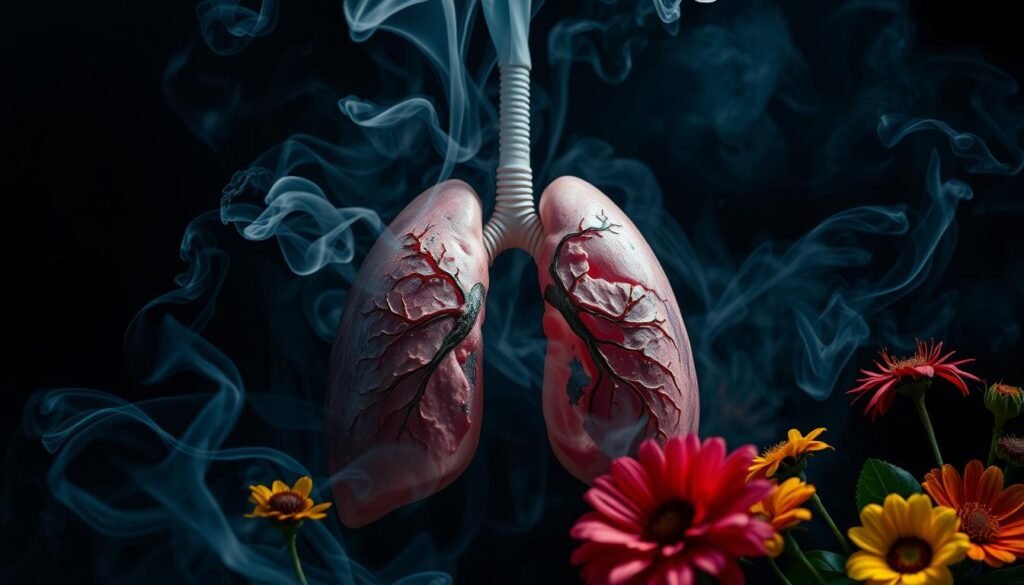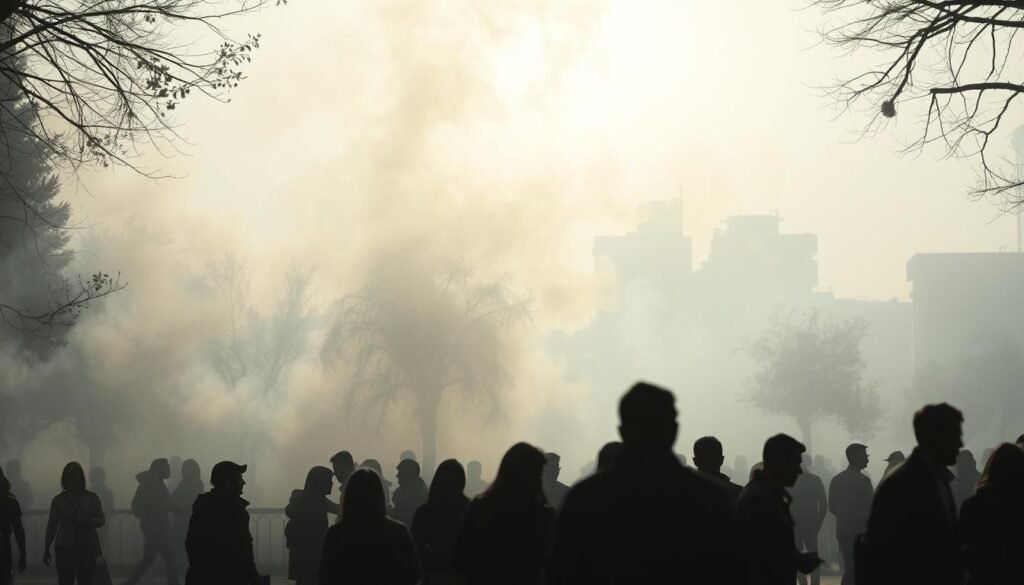In the United States, about 80% to 90% of lung cancer deaths are due to smoking. This high number shows the strong link between smoking and lung cancer. Smoking greatly increases the risk of developing lung cancer. Smokers are 15 to 30 times more likely to get lung cancer than non-smokers. Knowing these facts is vital in fighting lung disease. It highlights how important it is to be aware and educated. For more information on lung cancer risks, including those from smoking, visit lung cancer prevention.
Key Takeaways
- Smoking is responsible for a significant percentage of lung cancer deaths in the U.S.
- Non-smokers can also be at risk due to secondhand smoke exposure.
- Lung cancer is often linked to various environmental factors, including radon.
- Preventing smoking could drastically reduce lung cancer diagnoses.
- Education and awareness are key to combating the stigma surrounding lung disease.
The Link Between Smoking and Lung Cancer
Smoking is the main cause of lung cancer, leading to about 80% of lung cancer deaths worldwide. It’s well known that smoking can lead to lung cancer. Heavy smoking is especially linked to small cell lung cancer. This kind hits smokers with long histories of smoking the hardest. On the other hand, non-small cell lung cancer includes types like squamous cell carcinoma and adenocarcinoma. These are slightly less common but still largely due to smoking.
The more cigarettes you smoke daily, and the longer you smoke, the higher your risk of lung cancer. Also, secondhand smoke can increase the risk for those who don’t smoke. Regulations against tobacco help by trying to reduce smoking and protect people from secondhand smoke. These efforts are key to lowering lung cancer rates in communities.
But smoking isn’t the only risk factor for lung cancer. Exposure to radon gas, workplace carcinogens like asbestos, and family history also play a role. The reasons behind lung cancer are complex, involving things like genetic mutations too. For deeper insights on these misconceptions about smoking and lung cancer, you can visit this resource.
Many lung cancer cases are only found when they’re already advanced. This makes treatment harder and lowers survival chances. However, there are ways to lower your risk. Quitting smoking, avoiding secondhand smoke, testing home for radon, and avoiding certain workplace exposures can help.
Understanding Lung Cancer Statistics
Lung cancer leads in causing deaths from cancer around the world. It beats breast, prostate, colon, and pancreatic cancers when combined. Studies show smoking might be the cause of lung cancer in 80% to 90% of cases. In the U.S., about 160,000 people die each year from lung cancer. This shows the huge need for increased awareness and steps for prevention.
Smokers are in great danger. They could be 30 times more likely to get lung cancer than non-smokers. Those who have stopped smoking still face a higher risk. People who have quit have a 7.2% chance of getting lung cancer in their lifetime. For current smokers, the risk jumps to 14.8%. But for men and women who never smoked, the risk is low, at 1.8% and 1.3% respectively.
About 20% of those who get lung cancer have never smoked. Among these, women make up about 16% and men about 10%. This points out that lung cancer isn’t just about smoking. There might be other factors, like genetics, involved.
Secondhand smoke also poses a big risk. Every year, secondhand smoke leads to 7,300 lung cancer deaths in the U.S. With smoking being a cause for 80% of lung cancer deaths, the need for strong health policies is clear.
| Demographic | Lifetime Risk of Lung Cancer | Annual Deaths from Lung Cancer |
|---|---|---|
| Men (Non-Smokers) | 1.8% | N/A |
| Men (Former Smokers) | 7.2% | N/A |
| Men (Current Smokers) | 14.8% | Approximately 160,000 |
| Women (Non-Smokers) | 1.3% | N/A |
| Women (Former Smokers) | 5.8% | N/A |
| Women (Current Smokers) | 11.2% | N/A |
It’s crucial to understand these stats to fight smoking. Quitting smoking can add up to 10 years to your life. We need research and help for both current and formers smokers to lessen this disease’s effects.
For a deeper look into smoking and lung cancer, more research is needed. Keeping up with lung cancer statistics helps health experts and activists find better solutions.
How Smoking May Cause Lung Cancer
Lung cancer is the top cause of cancer deaths globally. Smoking is often to blame for most cases. By looking at the harmful substances in cigarettes, we can understand why. This view shows how smoking greatly increases lung cancer risk.
Carcinogens in Cigarettes
Cigarettes pack a mix of dangerous substances, called carcinogens. Notable carcinogens in cigarettes include:
- Formaldehyde
- Benzo[a]pyrene
- Arsenic
- Hydrogen cyanide
- Radon
These chemicals harm DNA, leading to cell mutations that could turn cancerous. Their link to lung cancer shows the serious risks of smoking. It explains the heightened lung cancer risk for smokers.
Impact of Long-term Smoking
Smoking over time greatly harms lung health. The longer and more you smoke, the higher your lung cancer risk. This constant exposure injures lung tissue and increases cell mutations. Conditions like Chronic Obstructive Pulmonary Disease (COPD) also arise from smoking. They make lung cancer even more likely for longtime smokers.
Smokers are about 25 times more likely to get lung cancer than nonsmokers. But quitting smoking does help—lung cancer risk drops significantly after stopping. No matter when you quit, it can greatly lower your disease risk.
Knowing about cigarette carcinogens and smoking’s long-term effects is empowering. Despite the dangers, help is available for those wanting to quit. This knowledge is key to fighting lung cancer.
Smoking May Cause Lung Cancer: A Closer Look
It’s important to understand how smoking can lead to lung cancer for public health. Inflammation from smoking is a big problem for lung health. Harmful cigarette chemicals cause lasting inflammation, changing lung tissue and increasing cancer risk.
DNA damage is also a key issue. Tobacco smoke’s carcinogens mutate lung cell DNA. These changes can kickstart processes that end in tumor growth. Most lung cancers, around 80%, are found in smokers.

There’s a strong link between Chronic Obstructive Pulmonary Disease (COPD) and lung cancer. Most COPD cases, between 85% and 90%, are due to smoking. People with COPD have a higher lung cancer risk because they share symptoms like coughing and trouble breathing. This makes spotting it early crucial.
The survival stats for lung cancer are bleak. Only 26.6% of patients live for five years past diagnosis. By preventing smoking and raising awareness, we can lower lung cancer rates and promote healthier lungs.
Nicotine Addiction and Its Consequences
Nicotine addiction is vital to understand when we talk about smoking challenges. It creates a strong need that keeps people smoking, even knowing the dangers. This addiction shows up through different behaviors, like needing to smoke and feeling bad when not doing so.
Behavioral Factors in Tobacco Use
What drives people to keep smoking lies a lot in behavior. Here’s how:
- Routine: Smoking becomes a part of daily life, like right after waking up, showing how deep the addiction goes.
- Social influences: When friends or family smoke, it makes quitting tougher for someone surrounded by smokers.
- Coping mechanisms: For some, smoking is a way to deal with stress or worry, making addiction stronger.
Impact on Respiratory Health
Smoking doesn’t just affect behavior; it hits health hard, especially the lungs. See what happens:
- Chronic obstructive pulmonary disease (COPD): This serious illness makes it really hard to breathe.
- Lung damage: Smoke damages lungs over time, stopping them from healing properly.
- Increased cancer risks: Smoking raises the risk of getting lung diseases, which leads to more deaths.
Secondhand Smoke: Risks to Others
Secondhand smoke is dangerous for both smokers and those nearby. Studies have shown that being around smoke can lead to lung cancer. It’s important to know how harmful passive smoking is for public health.
Statistics on Secondhand Smoke Exposure
Here are some scary facts about secondhand smoke:
- Non-smokers exposed to it have a 20–30% higher chance of getting lung cancer.
- Each year, more than 7,300 non-smokers die of lung cancer from secondhand smoke in the U.S.
- Secondhand smoke causes nearly 34,000 early deaths from heart disease in the U.S. each year.
- Being around smoke when pregnant can lead to babies that are smaller at birth and have a higher risk of childhood cancers.
- Infants in smoky environments are more likely to die from sudden infant death syndrome (SIDS).
- Children breathing in secondhand smoke get sick more often with lung infections, have worse asthma, and their lungs don’t grow as well.
Health Effects on Non-Smokers
The impact of passive smoking is severe and wide-ranging. Secondhand smoke has over 7,000 chemicals, including many that cause cancer. Being around this smoke regularly can cause serious health problems.
- Non-smokers can see their risk of heart disease and stroke jump by 25–30% and 20–30%, respectively.
- It can lead to breathing problems like pneumonia and bronchitis in kids, as well as worse asthma.
- There might also be a link between secondhand smoke and other cancers, like breast cancer and brain tumors.
Laws help reduce secondhand smoke in public places. But, keeping smoke out of homes and private areas is also key. Smoke-free spaces greatly lower health risks for everyone, especially kids.

The Role of the Tobacco Industry
The tobacco industry impacts our views and usage of tobacco products. It has used different marketing strategies over the years. This has happened amidst changing tobacco regulations. We need to understand this to see its effect on public health and smoking-related issues.
Marketing Strategies and Public Perception
The tobacco industry’s marketing has tried to make smoking look normal and attractive. They’ve targeted young people and others by sponsoring events and online. This creates a false belief that smoking is cool or desirable. Also, they push products like smokeless tobacco and vapes as safer, which isn’t fully true.
Regulatory Challenges and Changes
Regulations try to stop these marketing strategies to decrease smoking. Yet, the tobacco industry often finds ways around these laws. Things like graphic warnings and ad limits help fight this. But we still need strong laws to cut down the industry’s influence. This is crucial to prevent diseases like lung cancer from tobacco use.
| Aspect | Impact |
|---|---|
| Marketing to Youth | Increases risk of long-term tobacco use |
| Smokeless Tobacco Promotion | Perceived as a safer choice, leading to health risks |
| Electronic Cigarettes Marketing | Targets young adults, posing health concerns |
| Regulatory Responses | Attempts to limit advertising and health claims |
Anti-Smoking Campaigns and Their Effectiveness
Anti-smoking campaigns are key for public health. They spread the word about tobacco’s dangers, including lung cancer. These efforts don’t just educate; they motivate smokers to quit and stop others from starting. The U.S. and Europe have used many strategies, resulting in fewer smokers over time.
The Tips From Former Smokers™ campaign has really made a difference. About 1.64 million smokers tried to quit because of it. Around 100,000 are likely to stay quit. On top of that, smoke-free laws help keep young people from starting smoking. These rules not only improve health right away but also cut down on secondhand smoke risks.

Studies show how effective these campaigns can be in fighting lung cancer. They suggest 1.65 million lung cancer cases could be avoided in 20 years with full tobacco control. The WHO Framework Convention on Tobacco Control backs these efforts. It calls for strong action against tobacco.
| Region | Preventable Lung Cancer Cases (%) | Tobacco Smoking Rates (%) |
|---|---|---|
| Western Europe | 24.5 | 36 (Men), 20 (Women) |
| Southern Europe | 23.1 | 36 (Men), 20 (Women) |
| Eastern Europe | 22.5 | 36 (Men), 20 (Women) |
| Northern Europe | 12.5 | 36 (Men), 20 (Women) |
In conclusion, anti-smoking campaigns are a major force against tobacco use. They rely on strict tobacco laws and public health efforts. Together, these actions lower smoking rates and lung cancer risks. It’s all about building a healthier world without tobacco’s harm.
Preventing Lung Disease: Strategies and Support
There are effective strategies for preventing lung disease. These include many resources and help from the community. For people who want to quit smoking, there are lots of programs to support them. Getting the right support makes the quitting process easier. This has a big impact on lung health and overall well-being.
Resources for Quit Smoking Support
If you’re trying to quit smoking, many resources can help. Support groups, hotlines, and online tools are key in offering help. They provide encouragement and practical tools to quit successfully. Connecting with others who are quitting can also offer strong support.
Some successful ways to quit include counseling and behavioral therapy. These focus on what motivates each person. Nicotine replacement therapies like patches and gums are helpful too. There are also mobile apps that help you track your progress and remind you of your goals.
Studies show that stopping smoking greatly lowers the risk of lung cancer. This is true no matter how long you’ve been smoking.
Community and Government Efforts
Community actions are important in fighting lung disease. Local groups run programs teaching the benefits of quitting smoking. Schools, jobs, and health systems work together for smoke-free places. Government actions support these efforts by reducing smoking rates through laws.
- Public awareness campaigns show the harms of smoking.
- There are free or low-cost services to help quit smoking.
- Laws limit where cigarette ads can be shown and where cigarettes can be sold.
Joining community efforts and using government resources can make quitting smoking easier. These joint actions play a big part in preventing lung disease. They help build healthier communities for everyone.
Conclusion
The link between smoking and lung cancer is strong, showing we need more lung cancer awareness and education. Around 1.5 million people die from lung cancer worldwide every year. This fact shows how critical the situation is. The Surgeon General’s report shows that cigarette smoke is full of carcinogens harmful to our lungs. Clearly, smoking can lead to lung cancer, so we must share information about its risks.
Most adult smokers in the United States started when they were 11 to 13 years old. This fact is worrisome because starting young can lead to health issues later in life. If things don’t change, over 200 million young people under 20 might die early from smoking-related illnesses. We need to support quitting smoking and prevent the youth from starting.
Pushing for stricter tobacco laws and local programs could greatly reduce smoking rates. By understanding how tobacco causes cancer through studies like the one found here, people can choose healthier lifestyles. The journey to healthier communities begins with awareness, support, and a united effort to lessen smoking’s harmful effects on future generations.